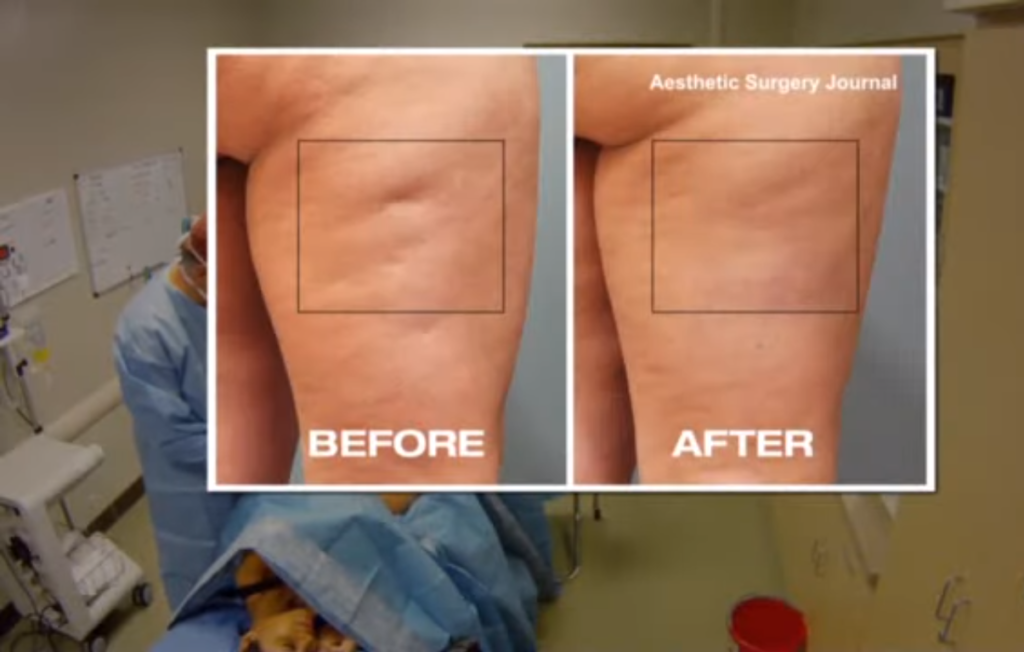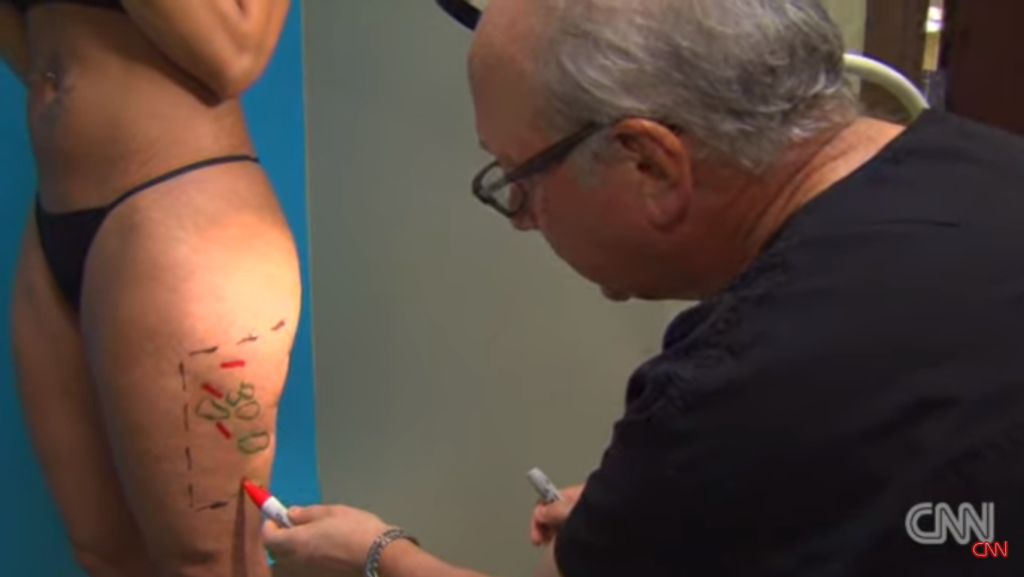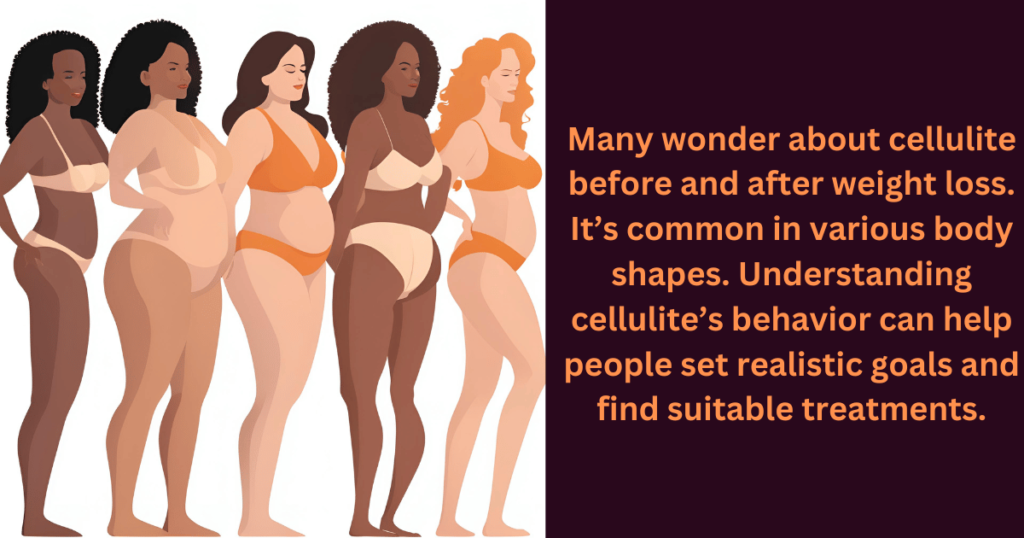Cellulite may diminish with weight loss but is not guaranteed to disappear. Fat loss can smooth the skin’s appearance, yet cellulite often persists due to its complex nature.
Battling cellulite can be a frustrating process for many. Despite shedding pounds, you might still notice the stubborn dimpling or “orange peel” texture on your skin, which is a common concern, especially among women. Cellulite forms due to fat deposits pushing through the connective tissue beneath the skin.
While overall weight loss can reduce fat and may improve the look of cellulite, it doesn’t always solve the problem entirely. Body composition, skin elasticity, and genetic factors also contribute to the appearance of cellulite. That’s why even after significant weight loss, a comprehensive approach, including dietary changes, exercise, hydration, and possibly medical treatments, might be necessary to achieve the desired skin texture.

Cellulite Demystified
Cellulite Demystified – a term that often conjures images of orange peel skin, regardless of size or weight. This natural phenomenon affects many, sparking both concern and curiosity. Unraveling cellulite’s mysteries, let’s explore its transformation before and after weight loss and distinguish fact from fiction.
What Is Cellulite?
Cellulite appears as dimpled, lumpy flesh on thighs, hips, buttocks, and belly. It’s more common in women due to the different fat, muscle, and connective tissue distribution. Cellulite forms when fat cells swell and push against connective tissue, causing the skin above to pucker. Weight loss can sometimes smooth its appearance, but may not always eliminate it.
Myths Vs. Facts
Understanding cellulite requires separating truths from widely believed myths:
| Myth | Fact |
|---|---|
| Only overweight people get cellulite. | Cellulite can affect individuals of all sizes and shapes. |
| Cellulite is just excess fat. | Cellulite involves fat, but it’s the connective tissue’s structure that creates dimpling. |
| Cardio exercises can eliminate cellulite. | Exercise may reduce fat and firm muscles, which can improve appearance but not rid cellulite completely. |
Diet and exercise can influence cellulite, but genetics and hormones also play crucial roles. No magic cure exists, but understanding cellulite can help manage expectations regarding body changes and weight loss.
Body Changes With Weight Loss
Losing weight transforms the body significantly. From fat distribution to skin texture, each pound shed can result in visible changes. People often notice differences in areas where cellulite was present. Weight loss might not erase cellulite completely, but the effects can be profound. Let’s explore how fat reduction and skin elasticity, as well as metabolic changes, contribute to the body’s post-weight-loss appearance.
Fat Reduction And Skin Elasticity
Weight loss begins with reducing fat cells in the body. Cellulite, characterized by dimpled skin, often lessens when these fat cells shrink.
- Fat cells shrink with weight loss and can lessen cellulite’s appearance.
- Skin elasticity plays a key role in how smooth the skin looks post-weight loss.
| Before Weight Loss | After Weight Loss |
|---|---|
| Fat cells larger | Fat cells smaller |
| Cellulite more visible | Cellulite less visible |
| Skin less elastic | Improved skin elasticity |
Adequate hydration and nutrition support skin’s ability to snap back. This can lead to smoother contours and a reduction in cellulite.
Metabolic Transformations
Weight loss accelerates metabolism, the process that converts food into energy. This transformation influences how effectively the body uses fat for energy, impacting cellulite.
- Metabolism speeds up, burning more calories even at rest.
- Efficient fat usage leads to continuous fat cell reduction.
Consistent exercise and smart eating boost metabolic rate, greatly improving body composition. This, in turn, can make cellulite less noticeable.
Impact Of Weight Loss On Cellulite
In the journey of shedding pounds, many wonder about the fate of their cellulite. Cellulite, with its distinct dimpled skin appearance, often becomes a focal concern. Understanding how weight loss impacts cellulite can guide expectations and management strategies.
Potential Reduction
Losing weight may decrease body fat levels, impacting cellulite appearance. Weight loss can lead to firmer muscles and tighter skin. This change might reduce the visibility of cellulite.
- Decreased overall body fat means less pressure on the skin’s connective tissues.
- Improved muscle tone can lead to a smoother skin surface.
- Hydration and nutrition are vital. They help maintain skin elasticity as you lose weight.
Why Cellulite May Persist
However, weight loss does not guarantee cellulite disappearance. Cellulite involves fat cells trapped within the skin’s connective fibers. These structures may not change, even with weight loss.
- Genetics play a crucial role in skin structure and texture.
- Hormonal factors could sustain cellulite, despite shedding pounds.
- Skin elasticity varies and might not rebound after weight loss, leaving cellulite visible.
For targeted cellulite treatment, consider professional options like laser therapy or massage.

Transformation Stories
Explore the remarkable ‘Transformation Stories’ of individuals who embarked on a quest to shed weight and reduce cellulite. These tales exemplify dedication, change, and the delights of achieving personal wellness goals. Behold the metamorphosis that weight loss can ignite, particularly when it comes to tackling cellulite. Draw inspiration from the real experiences that highlight the struggles and triumphs on the path to a smoother, healthier physique.
Real-life Weight Loss Journeys
- Maria’s Story: Lost 30 pounds in six months
- Cellulite Change: From noticeable dimples to smoother skin
- Secret Weapon: Balanced diet and strength training
Maria’s before-and-after photos reveal a radical shift. Her consistent routine led to toned muscles, aiding in cellulite reduction.
- John’s Transformation: Shed 45 pounds over a year
- Cellulite Visibility: Significant reduction post-weight loss
- Strategy: High-intensity workouts and hydration
John’s commitment to fitness reshaped his body. Intense exercises diminished the fat deposits causing cellulite.
How They Tackled Cellulite
- Healthy Eating: Adequate nutrients, less processed foods.
- Regular Exercise: Combining cardio with strength training.
- Hydration: Drinking plenty of water for skin elasticity.
- Skincare: Using creams to firm the skin’s appearance.
The narrative emphasizes the link between a healthy lifestyle and smoother skin. Consistency in diet and exercise is key.
| Person | Weight Loss | Cellulite Reduction | Key Methods |
|---|---|---|---|
| Linda | 25 pounds in 4 months | Less visible | Yoga and vegan diet |
| Mike | 50 pounds in 8 months | Greatly reduced | Cycling and high-protein diet |
Linda’s and Mike’s scenarios illustrate diverse approaches yielding significant cellulite improvement.
Before And After: Analysing Photos
When it comes to the transformation of one’s body, the most dramatic showcases are often found within before and after photos, particularly in cellulite’s visual changes after weight loss. These compelling images could tell a thousand words about someone’s journey and progress. However, it is crucial to approach these images with a discerning eye to truly understand the story they are telling.
Visual Evidence
Visual evidence plays a significant role in the narrative of cellulite reduction. Before and after photos serve as a powerful tool to see the difference in skin appearance. Comparing side by side images can highlight the changes before and after weight loss, showing smoother skin texture and a decrease in visible cellulite.
- Look for changes in skin tone and texture.
- Observe shadows and contour differences.
- Note any muscle definition that may have emerged.
Understanding Photo Authenticity
Gauging the authenticity of these transformations ensures we don’t get misled by potential digital enhancements. To discern the truthfulness in before and after photos, certain clues can be identified:
| Authenticity Clue | Details |
|---|---|
| Consistent Lighting | Check if both photos have similar lighting to prevent misleading shadow play. |
| Same Angles | Photos taken from the same angle indicate a more accurate comparison. |
| Timestamps | Validating the date when each photo was taken shows a chronological progression. |
Date stamps and consistent clothing are additional factors that support photo legitimacy and thus can be relied upon to provide a true representation of before and after weight loss results.
These elements of analysis allow for a more objective and clearer understanding of before and after transformations. Keep them in mind to ensure what you see translates into a real success story. Engage with cellulite before and after photos wisely, observing every detail, questioning the context, and celebrating genuine progress.
Weight Loss Techniques Explored
Embarking on a weight loss journey can be challenging but rewarding. A common goal for many is to reduce the appearance of cellulite. Let’s explore how different weight loss techniques can have an impact before and after this process.
Dietary Approaches
A balanced diet is crucial for weight loss and can affect cellulite visibility. Here are key nutritional strategies:
- Hydration: Drink plenty of water. It helps flush out toxins.
- Whole Foods: Eat fruits, vegetables, and lean proteins.
- Fiber: Fiber-rich foods promote digestion and metabolism.
Exercise Routines
Regular exercise is essential for toning muscles and improving skin elasticity. Here’s how to create an effective workout plan:
- Cardio: Activities like running or cycling burn fat.
- Strength Training: Lifting weights builds muscle, reducing cellulite.
- Consistency: Aim for 30 minutes of exercise most days.

Non-surgical Cellulite Treatments
Cellulite can linger even after weight loss. Fear not! There’s a range of non-surgical methods to smooth out these frustrating dimples. Let’s explore some popular treatments that don’t require going under the knife.
Topical Solutions
Topical creams and lotions promise smoother skin with regular application. Ingredients matter. Look for retinol, caffeine, and antioxidants. These substances can tighten and hydrate the skin.
- Retinol – Boosts collagen. It thickens skin over time.
- Caffeine – Shrinks fat cells. It makes skin look firmer.
- Antioxidants – Repair skin cells. They protect against damage.
Massage Therapies
Massages improve circulation and may reduce cellulite appearance. The methods differ but aim for similar results: tighter, more toned skin.
| Type of Massage | Benefits |
|---|---|
| Manual Lymphatic Drainage | Removes toxins. Promotes lymph flow. |
| Deep Tissue Massage | Breaks up connective tissue. Stimulates blood flow. |
| Endermologie | Uses suction and rollers. Smooths out dimples. |
Surgical Options For Cellulite Removal
Understanding the journey of cellulite before and after weight loss is crucial.
Weight loss can reduce the appearance of cellulite, but sometimes it persists.
This is where surgical options come into play.
These procedures aim to remove or reduce cellulite, offering a smoother skin texture.
Let’s explore the popular surgical methods.
Liposuction: Pros And Cons
Liposuction is a well-known surgical technique that removes fat cells from the body.
It can reshape specific areas, potentially reducing the look of cellulite.
| Pros of Liposuction | Cons of Liposuction |
|---|---|
| Can remove large amounts of fat | May not effectively target cellulite |
| Offers immediate results | Requires recovery time |
| Contours body shape | Can be costly |
Laser Treatments
Laser treatments use concentrated light to target cellulite.
These treatments can break down fat cells and stimulate collagen production, improving skin elasticity.
- Less invasive than liposuction
- Promotes skin tightness
- Minimal recovery time
Lifestyle’s Role In Cellulite Formation
Lifestyle choices play a pivotal role in the formation and persistence of cellulite. Too often, cellulite is solely associated with weight. In reality, factors like diet, hydration, and physical activity influence its appearance. Understanding the impact of lifestyle can empower you to reduce cellulite and improve skin texture, irrespective of weight loss.
Diet And Hydration
A balanced diet rich in fruits, vegetables, and fibers can help detoxify the body. This detox aids in reducing fat deposits that contribute to cellulite. Adequate hydration also flushes out toxins and keeps skin elastic and firm. Consider these nutrition tips:
- Eat less salt to reduce fluid retention
- Consume foods with Omega-3 fatty acids for skin health
- Stay hydrated with water over sugary drinks
| Food Type | Benefits |
|---|---|
| Leafy Greens | Enhances circulation |
| Whole Grains | Supports metabolism |
Physical Activity Impact
Regular exercise boosts blood flow and lymphatic drainage, enhancing skin texture. Focus on activities that build muscle tone under cellulite areas. Combine strength training with cardio for the best results. Here’s a simple workout approach:
- Start with a 5-minute warm-up
- Add 20 minutes of strength training
- Include 15 minutes of cardio exercises
- Finish with cool-down stretches
Remember, consistency is key. Aim for at least 30 minutes of activity, five times a week.
Preventing Cellulite Reoccurrence
After the hard work of weight loss, maintaining your new body is key. However, the shadow of cellulite reoccurrence looms large. Let’s explore effective strategies to keep your skin smooth and free from cellulite.
Maintaining Weight Loss
Weight stability is critical in keeping cellulite at bay. Gradual changes in lifestyle trump quick fixes. Here’s a quick checklist to help you maintain your weight loss:
- Regular Exercise: Balance strength training and cardio to keep muscles toned and reduce fat accumulation.
- Healthy Eating Habits: Focus on whole foods and balance your macronutrients to fuel your body correctly.
- Consistent Schedule: Eating and exercise routines help regulate your body’s metabolism, aiding in weight management.
- Monitoring Progress: Use tools like Scales or body composition tests to stay on track.
Long-term Skin Care Routines
Investment in skin health is crucial for cellulite prevention. Embrace these long-term skin care practices:
| Practice | Details | Frequency |
|---|---|---|
| Hydration | Drink plenty of water to keep your skin hydrated and elastic. | Daily |
| Moisturizing | Use products that firm the skin and improve its texture. | 2x daily |
| Exfoliation | Remove dead skin cells to stimulate circulation and cell renewal. | 2-3x a week |
| Professional Treatments | Consider massage or laser treatments to enhance skin appearance. | As needed |
By integrating these habits, your skin remains firm and cellulite-free, complementing your weight maintenance journey.
Psychological Effects Of Cellulite
Cellulite often carries a stigma that reaches far beyond skin deep. Whether peering into the mirror or flipping through magazine pages, the presence of cellulite can trigger a wide array of emotions. Understanding these effects is crucial, especially in the context of weight loss, where changes in the body’s appearance can be both motivating and, at times, disheartening.
Self-esteem And Body Image
Feelings of attractiveness and self-worth are closely tied to body image. Cellulite, appearing as dimpled or lumpy skin, can significantly dampen self-esteem. People frequently scrutinize their reflections, searching for smooth, flawless skin. When cellulite remains after weight loss, this can lead to frustration. Expectations of a “perfect” body post-weight loss often clash with reality, sometimes ignoring the substantial health benefits gained.
Studies point out that individuals with cellulite may avoid social situations or certain clothing styles. They may feel self-conscious in shorts or swimsuits. This alters social interactions and can limit life experiences. A change in self-perception after weight loss is, therefore, a complex journey. Positive reinforcement and realistic body images help in restoring confidence.
The Mental Health Connection
The link between cellulite and mental health is undeniable. The quest for a cellulite-free appearance can lead to stress and anxiety. This preoccupation can spiral into a persistent concern over one’s body, sometimes leading to disorders such as body dysmorphic disorder (BDD) or depression.
Medical professionals advise focusing on health and fitness goals rather than aesthetics. Celebrating weight loss victories can shift the spotlight from self-criticism to self-care. A balanced view of one’s body fosters better mental health and overall wellbeing.
- Recognize cellulite as a common, often unavoidable, skin condition.
- Shift focus to health improvements and accomplishments.
- Seek support from friends, family, or professional counselors when needed.
The Science Behind Cellulite
Cellulite, the bumpy skin texture nicknamed ‘orange peel’, can be a stubborn issue. Understanding the science behind cellulite is crucial for anyone looking to see changes before and after weight loss. It involves connective tissues and hormonal components, each playing a pivotal role in cellulite formation. Let’s dive deeper into the underlying factors.
Connective Tissue Structure
The structure of our connective tissue is key to understanding cellulite. Cellulite occurs when fat cells push up against the skin, while fibrous connective cords pull it down. This action creates an uneven surface or dimpling effect. Picture a cushion with buttons, where the buttons are pulling the fabric into the cushion; this is similar to how cellulite forms on our skin. Changes in your body’s weight can impact how noticeable this dimpling is. Here’s a snapshot of what happens under the skin:
- Subcutaneous fat cells swell and push upwards.
- Connective tissue, composed of collagen, tightens and pulls down.
- Skin dips at points where connective tissue is attached, creating dimples.
Hormonal Influences
Hormones play an influential role in cellulite development. Estrogen, insulin, noradrenaline, thyroid hormones, and prolactin all contribute to cellulite production. These hormones can affect blood flow, fat, connective tissue, and fluid retention. A change in weight can alter hormone levels, which may reduce or increase the appearance of cellulite. Here’s a brief overview of hormonal effects:
| Hormone | Role in Cellulite |
|---|---|
| Estrogen | May increase fat deposits and impact blood flow. |
| Insulin | Can increase fat storage and lead to cellulite. |
| Noradrenaline | Affects fat breakdown and can influence cellulite. |
| Thyroid Hormones | Regulate metabolism, affecting body weight and cellulite. |
| Prolactin | May increase fluid retention, exacerbating cellulite. |
Gender Differences In Cellulite
Many ask why cellulite seems to favor genders. Science reveals a fascinating look into why this occurs. Before and after weight loss, these differences can be even more pronounced. Let’s decode the mystery behind why cellulite affects women and men differently.
Prevalence In Women Vs. Men
Cellulite commonly appears in women, but men can have it too. Statistically, it’s far more prevalent in the former. This is why:
- Women’s fat distribution often leads to cellulite around thighs and buttocks.
- Men have thicker skin and different fat structures.
- Hormonal factors also play a huge role in cellulite development.
Biological Factors
Biologically, two main factors contribute to cellulite discrepancy between genders:
| Factor | Women | Men |
|---|---|---|
| Hormones | Estrogen encourages fat to accumulate. | Testosterone does not promote cellulite. |
| Connective Tissue | Vertical tissue leads to dimpling effect. | Crisscross pattern prevents dimpling. |
Understanding these differences is key when exploring cellulite treatment or analyzing before and after weight loss scenarios. A tailored approach often yields the best results.
Cellulite In Different Body Types
Many wonder about cellulite before and after weight loss. It’s common in various body shapes. Understanding cellulite’s behavior can help people set realistic goals and find suitable treatments.
Pear Vs. Apple Shapes
Body shape influences where cellulite appears. Pear-shaped individuals store fat in hips and thighs. Where lighter skin shows cellulite clearer. Apple shapes carry weight around the midsection, lessening cellulite visibility. Both types benefit from targeted exercise.
Bmi And Cellulite Correlation
BMI doesn’t predict cellulite. It can occur in all sizes. Higher BMI might increase cellulite due to more fat deposits. Yet, lean individuals also experience it. A balanced diet and regular fitness can reduce cellulite’s appearance regardless of BMI.

Natural Remedies For Cellulite Management
Natural Remedies for Cellulite Management offer a gentle and sustainable approach to improving the appearance of dimpled skin. Although weight loss can reduce cellulite, it might not eliminate it. Various natural methods may enhance skin texture and tone without harsh chemicals or invasive procedures. Discover homemade solutions and herbal aids to manage cellulite.
Home Scrubs And Packs
Easy-to-make exfoliants can smooth the skin’s surface. These home remedies encourage blood flow, assisting in the reduction of cellulite appearance.
- Coffee Scrub: Mix ground coffee with coconut oil and sugar for a natural exfoliating scrub.
- Seaweed Wrap: Seaweed mixed with clay and olive oil creates a detoxifying pack for skin.
- Oatmeal Scrub: Combine oatmeal with honey and a touch of cinnamon to gently exfoliate.
Herbal Supplements
Herbs may support skin health from the inside. Consider these supplements with a healthcare provider to ensure they fit your health plan.
| Herb | Benefit |
|---|---|
| Gotu Kola: | Promotes collagen production, firming skin. |
| Ginkgo Biloba: | Improves circulation, reducing cellulite visibility. |
| Dandelion: | Aids detoxification, potentially minimizing cellulite. |
Expert Tips For Cellulite Reduction
Cellulite can be a stubborn issue, but don’t lose hope. Experts share their secrets for reducing those dimples. Whether you’re on a weight loss journey or wanting to refine your skin’s texture, their advice is gold. Bumpy skin can become smoother with the right approach.
Dermatologists’ Recommendations
Beautiful skin is closer than you think. Achieve a firmer look with these steps:
- Stay hydrated – drink water to keep skin supple.
- Use a firming cream – ingredients like retinol may help.
- Consider laser treatments – a professional option for tougher cases.
Consistency with treatments is key. Always protect your skin from the sun too.
Fitness Trainers’ Advice
Strong muscles make skin look smoother. Get moving with these fitness tips:
- Focus on strength training – build muscle to support skin.
- Include cardio workouts – burn fat and boost circulation.
- Stretch regularly – improve flexibility and skin elasticity.
Mixing up these exercises can lead to visible changes. Embrace patience; your skin will thank you.
The Role Of Genetics In Cellulite
Many people notice changes in cellulite before and after weight loss.
Cellulite can be stubborn, and its appearance often puzzles those aiming for smoother skin.
One key factor influencing cellulite is genetics.
Inherited Predisposition
Your DNA plays a huge part in cellulite development. Genes determine skin structure, fat distribution, and metabolism.
- Collagen fibers that are less elastic may lead to cellulite.
- Fat cells vary in size and number from person to person.
These factors come from your parents. If they have cellulite, you might get it too.
Can Lifestyle Overcome Genetics?
While genes are important, your choices also matter. You can fight cellulite with:
- Healthy eating to manage body fat.
- Regular exercise to tone muscles.
- Staying hydrated for firm skin.
These habits won’t erase genetics. But they can improve cellulite appearance. It’s a balance between the two.
Fashion And Cellulite Concealment
Fashion and Cellulite Concealment play a crucial role in how we perceive our bodies, especially when it comes to changes post-weight loss. Many share concerns about cellulite, which often remains even after shedding pounds. Let’s explore stylish ways to feel confident and look your best, cellulite notwithstanding.
Clothing Choices
Dressing smartly can make a world of difference. Here are tips for selecting outfits that help conceal cellulite:
- Choose high-waisted leggings for snug support.
- Opt for patterned fabrics that distract the eye.
- Select thick, quality materials that offer good coverage.
- Wear A-line skirts that float away from the body.
- Look for clothes with strategic draping around problem areas.
Contouring With Makeup
Makeup isn’t just for faces. It can work wonders on the body too. Discover quick tricks to smooth the look of cellulite:
- Start with a primer to create a smooth canvas.
- Use body foundation matching your skin tone to even out.
- Employ bronzer and highlighter to contour and define.
- Finish with setting spray for a flawless, lasting look.
Cellulite Misconceptions Cleared Up
Cellulite Misconceptions Cleared Up – many of us wrestle with the dimpled appearance on our thighs and buttocks, often labelled as cellulite. Common myths shroud the topic, causing confusion about what cellulite really is and how it relates to weight loss. Let’s explore these misconceptions and reveal the truth behind cellulite’s stubborn persistence.
Weight Loss Equals No Cellulite?
Not always. It’s a common belief that losing weight will also rid you of cellulite. Unfortunately, it’s not that straight-forward. Cellulite occurs when fat deposits push through the connective tissue beneath the skin, creating a lumpy appearance. While shedding pounds can reduce fat, it doesn’t ensure the disappearance of cellulite.
- Body Composition: Muscle tone can influence the visibility of cellulite.
- Skin Elasticity: Firmer skin can mask cellulite, while thinner or more stretched skin might not.
- Genetics: Your genes may dictate your predisposition to cellulite, regardless of weight.
Does Cellulite Indicate Poor Health?
Simply put, no. Cellulite is not a health warning sign. It’s a cosmetic issue and a perfectly natural occurrence for many people. Men and women of all shapes and sizes can have cellulite – it’s not limited to those who are overweight.
Understanding the non-correlation between cellulite and overall health empowers us to approach this cosmetic concern without unwarranted worry about our well-being.
Final Thoughts On Cellulite Transformation
When talking about cellulite transformation, we address the changes that occur as one undergoes weight loss. Many hope to see cellulite reduction as part of their transformation journey. Understanding what to expect can lead to a more positive experience.
Embracing Body Positivity
Body positivity is key to feeling good about your cellulite transformation. It’s about loving your body at every stage. This mindset helps you appreciate your body’s uniqueness. Remember, cellulite is normal and present in most bodies.
- Love your body’s journey.
- Cellulite does not define you.
- Celebrate small wins and changes.
Setting Realistic Expectations
It’s crucial to set achievable goals for your body. Not all bodies react the same to weight loss. Some may see cellulite diminish, while others may not. Genetics play a big role in this.
| Weight Loss Impact | Cellulite Change |
|---|---|
| Minor loss | Little to no change |
| Moderate loss | Some visible reduction |
| Significant loss | More pronounced reduction |
Stay motivated by your health gains rather than cellulite alone. Focusing on overall wellness brings the best outcomes.
Frequently Asked Questions Of Cellulite Before And After Weight Loss
Can Cellulite Go Away With Weight Loss?
Weight loss can reduce the appearance of cellulite, but it may not eliminate it completely. Genetics and skin elasticity also play roles in cellulite visibility.
How Long Does It Take To Reduce Cellulite On Legs?
Reducing cellulite on legs typically takes 3-6 months with consistent lifestyle changes, such as regular exercise, healthy eating, and ample hydration. Results vary based on individual body types and the treatment methods used.
Does Cellulite Go Away With Muscle Gain?
Gaining muscle may reduce the appearance of cellulite, as it tones the body and improves skin elasticity. However, it does not completely eliminate cellulite.
What Exercises Get Rid Of Cellulite?
Exercises like squats, lunges, and step-ups can help reduce cellulite by toning muscles and improving circulation. High-intensity interval training (HIIT) also targets fat loss, aiding in cellulite reduction. Consistency and a healthy diet enhance results.
Does Weight Loss Reduce Cellulite?
Losing weight can help diminish the appearance of cellulite, but it may not completely eliminate it due to skin elasticity and body composition factors.
How Does Cellulite Change Post Weight Loss?
After weight loss, cellulite may become less noticeable, but skin laxity and remaining fat deposits can still maintain its presence.
Can Toning Muscles Reduce Cellulite Visibility?
Toning muscles through exercise tightens the skin’s appearance, which can help reduce the visibility of cellulite.
What Causes Cellulite To Appear Worse?
Cellulite can appear worse due to factors like poor diet, dehydration, lack of muscle tone, and increased body fat percentage.
Conclusion
Embarking on a weight loss journey often brings changes to cellulite appearance. While not a guaranteed fix, shedding pounds can reduce its prominence. It’s important to embrace healthy living regardless of aesthetic outcomes. Remember, self-love and body positivity should navigate your wellness path.
Stay determined, stay healthy.

